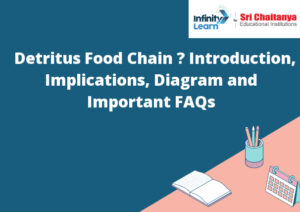Table of Contents
Detritus Food Chain
In an ecosystem, there are many different food chains. A food chain is the sequence of who eats whom in an ecological community. In a detritus food chain, dead organic matter is the ultimate source of food energy. Detritus food chains are found in all types of ecosystems, including terrestrial and aquatic ecosystems.
Detritivores are the key players in detritus food chains. Detritivores are animals that eat dead organic matter. They include bacteria, fungi, insects, and other animals. Detritivores not only break down dead organic matter into smaller pieces, but they are also consumed by other organisms.
Dead organic matter is a source of essential nutrients, such as nitrogen and phosphorus. When detritivores consume dead organic matter, they also release these nutrients back into the ecosystem. This recycling of nutrients is essential for the health of ecosystems.
Detritus food chains are also important for the decomposition of organic matter. Decomposition is a natural process that breaks down dead organic matter into simpler substances. This process is essential for the health of ecosystems because it helps to cycle nutrients and also helps to keep the ecosystem clean.
Detritus food chains play an important role in the environment and also they are essential for the health of ecosystems.

The Implications of the Detritus Food Chain
The detritus food chain is a food chain that starts with decomposing organic matter and ends with scavengers. The decomposing organic matter broken down by bacteria and by other microorganisms, including the scavengers which generally eats the bacteria and other microorganisms.
Detritus Examples
Detritus is a term used in ecology to refer to the non-living parts of an ecosystem. This includes things like dead leaves, broken branches, and other bits of organic matter. Detritus is an important for the ecosystem because it provides food and nutrients for microorganisms and also to the other animals.
Importance of Detritus Food Chain
Detritus food chains are the pathways through which energy and materials transfer from dead organic matter to consumers. These pathways play an important role in the cycling of matter and energy in ecosystems. Detritus food chains are the dominant pathway of energy and matter flow in many ecosystems, including forests and wetlands. In these ecosystems, detritus food chains are often the only pathway of energy and matter flow.
Detritus food chains are important for many reasons.
- Firstly, they provide a major source of energy and nutrients for many organisms also.
- Secondly, they play a key role in the recycling of matter and energy in ecosystems.
- Thirdly, they help to control populations of decomposers and other organisms.
- Fourth, they can help to stabilize ecosystem processes.
- Fifth, they can provide valuable ecosystem services, soil formation and water purification.
Related Links:
Frequently Asked Questions (FAQs) on Detritus Food Chain
What is a Detritus Food Chain (DFC)?
A Detritus Food Chain (DFC) represents the flow of energy and nutrients in an ecosystem through the decomposition of organic matter.
What does a DFC involve?
A DFC involves decomposers, such as bacteria, fungi, and detritivores, that feed on dead plant and animal material, breaking it down into simpler compounds.
How does a DFC start?
A DFC starts with the remains of dead organisms, like fallen leaves, animal droppings, or decaying plants.
What are detritivores?
Detritivores are organisms that directly consume detritus (dead organic matter) as their primary food source, aiding in its decomposition.
What role do decomposers play?
Decomposers, like bacteria and fungi, break down detritus into smaller molecules, releasing nutrients back into the ecosystem.
Why is DFC important?
DFCs recycle nutrients, making them available for plants and other organisms, contributing to ecosystem sustainability.
How does energy flow in a DFC?
Energy flows as decomposers break down detritus, and detritivores consume them, transferring energy from dead matter to higher trophic levels.
What's the connection to the food chain?
DFCs are a vital part of ecosystems and connect primary consumers (herbivores) with higher consumers (carnivores) in the food chain.
Where are DFCs commonly found?
DFCs are present in various ecosystems, from forests to aquatic environments, playing a role in nutrient cycling.
How does DFC contribute to ecosystem balance?
DFCs prevent the accumulation of dead matter, recycling nutrients and maintaining the balance between life and decay in ecosystems.



